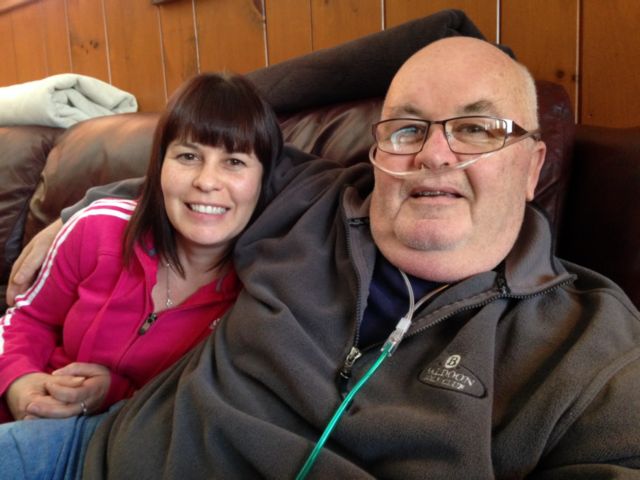
A Wallaceburg man is being forced to put a price tag on life, as he continues to battle a rare and progressive lung disease.
John McDonald, 63, was diagnosed with idiopathic pulmonary fibrosis (IPF) about three years ago. The disease has no known cause and is characterized by scarring of the lungs, which restricts a persons ability to breathe, ultimately resulting in death.
The life expectancy for someone diagnosed with IPF is between two and 15 years.
McDonald told the Sydenham Current he and his family have accepted the fact that this diagnosis and disease is a death sentence.
“I don’t know what is coming, other than they’re telling me I won’t wake up one day,” he said.
McDonald said he worked at different factories during his career, including a stint at the Wallaceburg Glass Factory. He retired last August when the disease became too much for him to endure at work.
He said he had been looking forward to spending retirement with his wife: working on their gardens and enjoying the occasional round of golf.
“I can’t really go anywhere,” McDonald said. “I have to minimize my contact with people. I can’t afford bad colds or the flu or pneumonia. I was an avid golfer. Loved to be outside… you can tell by the size of my property, I don’t mind cutting the grass, I don’t mind looking after the pool, the ponds, helping my wife with the gardens. I don’t mind, in fact it was what was going to keep us busy in retirement. Now, I don’t know if I’m going to be able to swing a club this year, I don’t think so.”
McDonald added: “I know I’m not going to be digging gardens and doing that stuff with my wife. Even just to go and rake the grass to do our spring clean-up, I’m going to have to hire somebody. My wife will do what she can, but she can’t do everything. In the meantime, they’ve doubled the amount of usage on the oxygen tank I use. So the hydro bill is going up.”
McDonald said there is a drug on the market called Esbriet, which is the only drug approved in Canada for the treatment of IPF. He said research has shown that Esbriet will slow the disease progression and decreases the decline of lung function.
However, the drug is not covered through public health funding (OHIP) and would cost an IPF patient $42,000 annually for the treatment.
“Here’s the scenario, I sell my home, I liquidate everything, I move my wife and I into a small apartment,” McDonald said. “I take the house money and the land money and buy as many years as you can buy. I’m not doing that to my family. We’re not living in the United States of America, we live in Canada. We look after our own here in Canada. I won’t spend several hundred thousand dollars, that my wife may need. I won’t do it.”
McDonald added: “After all my years of working, after all the OHIP I’ve paid into, all the Canada Pension I’ve paid into, I’m not going to over use it. I’ll be dead long before that ever happens. On a chance that I might get a couple more years, you’re going to deny me that drug? Or as a government, you’re not going to find a way to get that drug in this country cheaper?”
The notion was raised at Queen’s Park in September last year, when a delegation from the Canadian Pulmonary Fibrosis Foundation attended, advocating for Esbriet to receive public funding.
Deb Matthews, the Minister of Health and Long Term Care, said they make decisions based on evidence and in regards to Esbriet “the Canadian Drug Expert Committee has recommended that Esbriet should not be funded because of inconsistent results.”
She said they are always open to new evidence.
“Why would you approve a drug that nobody can afford to buy?” McDonald said. “When you’re looking at timelines of two to five years… seven being the mean average. That tells me there are a lot of people going in five or less. Do you think they have time to wait two or three years for them to decide whether OHIP will cover it? What is wrong with that system?”
McDonald’s daughter Shannon is doing her part to help raise awareness about the issue.
She is joining another family from Wallaceburg, who is also dealing with IPF, in supporting a formal petition to be sent to the Legislative Assembly.
“This isn’t going to change anything for my Dad,” she said. “But in the same token, when you live with it you feel like you have to do something. I’m not saying that this is the perfect drug or that we know everything about it… but it’s the only drug, it’s the only thing. It’s working for some people, it’ working in other countries. We’re Canada, we’re suppose to have a decent health system and it’s the only drug.”
Shannon said watching her father struggle with the disease has been difficult for their entire family.
“He has really good days and really bad days,” she said. “There were times in the beginning before he was hooked up to oxygen that he would violently cough for days. It’s a painful disease and it’s a cruel disease to watch, such as cancer. In all those other instances, there is a chance because there is a choice for treatment, whereas with this there is none, so basically you have no hope. Everybody going through something like this needs hope.”
Shannon said she is concerned because she knows other people in the community have suffered and died from this disease.
“The people that have this disease or condition are people who are blue collar workers,” she said. “I’m filling in blanks from different things I’ve read… but it could have been caused by silica, which is the sand that would have been used in the Glass Factory. It’s similar to the disease and conditions to people that have breathed asbestos.”
Shannon said an event to rally people to sign the petition is in the works.
John McDonald said he is also hoping to set up a face-to-face meeting with Lambton-Kent-Middlesex MPP Monte McNaughton, in order to convey his message of making Esbriet a publicly-funded medication.
“My hope is that they will find a way to get the drug into Canada cheaper and that they find a way to make it affordable for those Canadians that need it,” he said. “Whether OHIP pays for it, or OHIP picks up 75 per cent and you pick up the other 25 per cent, like I’m doing with the oxygen air. You just can’t expect Canadians to walk out and spend $42,000 for a drug. That is why they brought in “Obamacare”, families were going bankrupt. Are we going to have families in Canada go bankrupt because we’re going to make people wait for a drug when people are dying in five years? It’s not right.”
Here are some more facts about IPF, courtesy of the Canadian Lung Association:
What causes IPF?
Although doctors and researchers do not understand the true cause of IPF, they know that the disease is linked to a number of risk factors including:
– genetic factors may play a role in causing IPF. If more than one member of your family has IPF, the disease is called familial pulmonary fibrosis.
– smoking tobacco, especially if you have IPF in your genes.
– Acid reflux, also known as gastro–esophageal reflux disease (or GERD) that occurs when acid from your stomach backs up into your throat.
– viral or bacterial lung infection – researchers have found certain viruses in the lungs of people with IPF. These viruses include Epstein-Barr and hepatitis C.
What are the symptoms of IPF?
The two main symptoms are:
– breathlessness (also known as shortness of breath or dyspnea). Usually the breathlessness of IPF first appears during exercise. Breathlessness can affect day-to-day activities such as showering, climbing stairs, getting dressed and eating. As scarring in the lungs gets worse, breathlessness may prevent any activity.
– dry hacking cough, usually lasting longer than 8 weeks
Other symptoms may (or may not) include:
– chest pain or tightness
– unexplained weight loss
– loss of appetite
– tiredness and loss of energy
– change of finger shape called “clubbing”
– cyanosis (blue lips, nail beds)
How is IPF diagnosed?
Idiopathic pulmonary fibrosis (IPF) can be hard to diagnose. Many lung diseases can cause breathlessness and cough. You may have to see more than one specialists, including a respirologist, to help with the diagnosis.
Your doctor will be determining if you have pulmonary fibrosis and trying to figure out if there is any cause for the pulmonary fibrosis or if it is idiopathic (IPF).
Your doctors may ask you questions about your home and work environments, your smoking history and your medical history. This will help them learn if there were any environmental, occupational, genetic, or other factors that could be linked to the development of pulmonary fibrosis.
Your doctor may do a physical examination, by examining your skin, fingernails and joints and listening to your chest with a stethoscope.
Here are some more statistic from the Pulmonary Fibrosis Foundation.

















Have you applied for Trillium funding?
Please feel free to drop into the Wallaceburg Wellness Centre to add your signature to this petition. Copies are at the front desk.